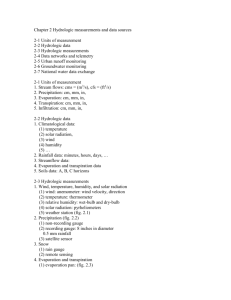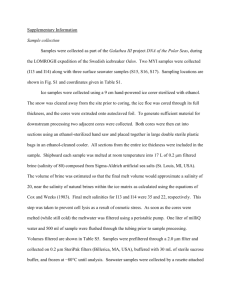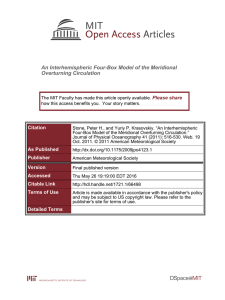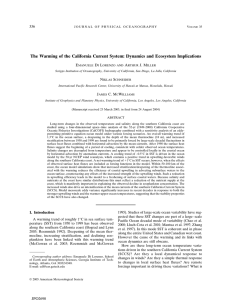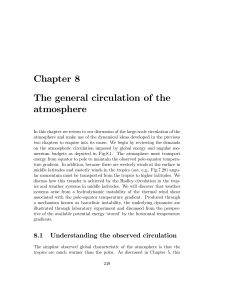Quiz 3 - Study Guidelines
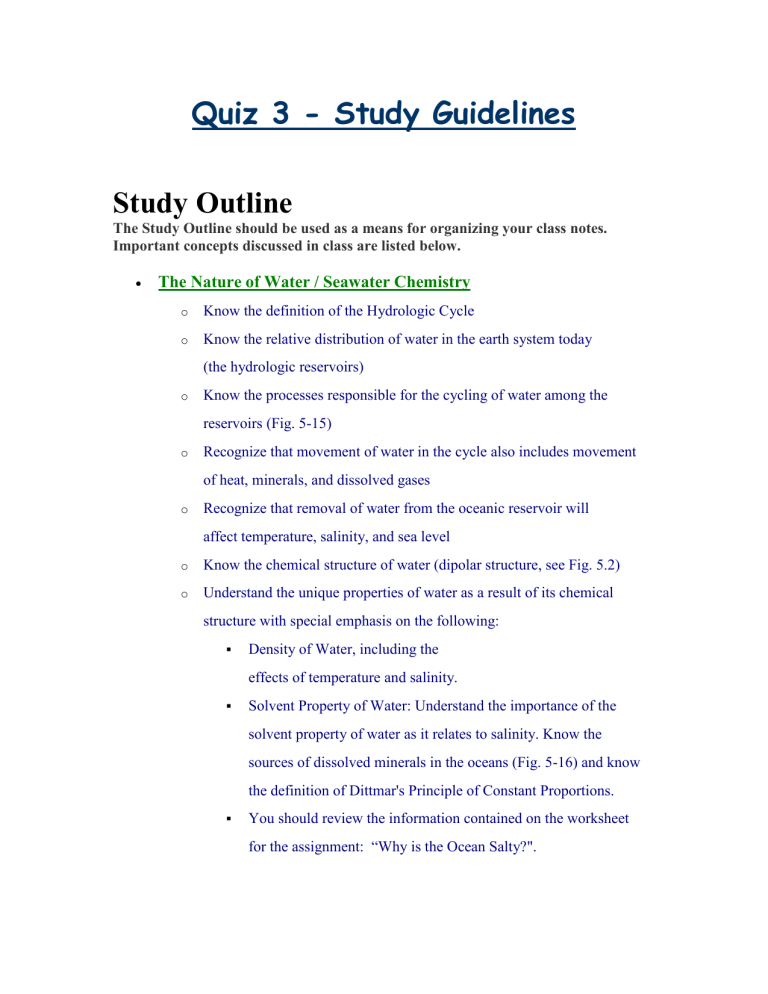
Quiz 3 - Study Guidelines
Study Outline
The Study Outline should be used as a means for organizing your class notes.
Important concepts discussed in class are listed below.
The Nature of Water / Seawater Chemistry
o Know the definition of the Hydrologic Cycle o Know the relative distribution of water in the earth system today
(the hydrologic reservoirs) o Know the processes responsible for the cycling of water among the reservoirs (Fig. 5-15) o Recognize that movement of water in the cycle also includes movement of heat, minerals, and dissolved gases o Recognize that removal of water from the oceanic reservoir will affect temperature, salinity, and sea level o Know the chemical structure of water (dipolar structure, see Fig. 5.2) o Understand the unique properties of water as a result of its chemical structure with special emphasis on the following:
Density of Water, including the effects of temperature and salinity.
Solvent Property of Water: Understand the importance of the solvent property of water as it relates to salinity. Know the sources of dissolved minerals in the oceans (Fig. 5-16) and know the definition of Dittmar's Principle of Constant Proportions.
You should review the information contained on the worksheet for the assignment: “Why is the Ocean Salty?".
Heat Capacity and Latent Heat of Water: Know the general importance of these properties as they relate to the storage and transfer of heat energy. (Fig. 5.6)
Air-Sea Interaction
o Know the general nature of solar and earth radiation in terms of the energy spectrum (Fig. 6.26) o Understand the heating of the Earth System with special focus on the following:
Know the effect of the Earth’s orbit around the Sun and the Earth’s axial tilt (Fig. 6-1)
Know the latitudinal effects on receipt of solar energy
(especially at high latitudes, Fig. 6-2)
Know the effects of atmospheric composition on heating the Earth
Know the basic heat budget for the Earth (Fig. 6.25)
Understand the role of the Greenhouse Effect in heating the Earth o
Understand the question of global warming
(and oceanography’s solution to the question - ATOC
Understand the general circulation of the Earth’s atmosphere with focus on the following:
Know the driving force of winds
(With specific focus on the roles of temperature and pressure)
Know the Coriolis Effect on atmospheric circulation
Know the basic structure of the Earth’s atmospheric circulation
(Fig. 6-10, focus on vertical circulation)
Review Questions
The following questions are designed to help you review the concepts presented in class.
You should refer to both your class notes and the textbook when answering the questions.
Remember to review the information from Assignment #4.
The Nature of Water / Seawater Chemistry
1.
Describe the Hydrologic Cycle, including the processes responsible for moving water among the various reservoirs.
2.
Is the Hydrologic Cycle closed or open? Is the Hydrologic Cycle balanced or unbalanced? Be able to explain or justify your answers!
3.
What is meant by the term "dipolar" when referring to the structure of the water molecule?
4.
As an example, sketch the dipolar water molecule.
5.
How is the density of water affected by changing temperature? What happens to the density/temperature relationship if the water is salty?
6.
How is salinity measured and reported by oceanographers?
7.
What element is most common in seawater? What is the importance of Dittmar’s
Principle of Constant Proportions?
8.
Compare Figure 5-8 which shows the latitudes of evaporation and precipitation with Figure 5-21 which shows the surface salinity of the oceans. Be able to explain the patterns that you see. What processes other than evaporation and precipitation play a role in determining sea surface salinities?
9.
Describe the importance of heat capacity and latent heat relative to the movement of water in the Hydrologic Cycle.
Air-Sea Interaction
1.
What is the nature of the energy received from the Sun?
How is this different from the energy radiated from the Earth?
2.
How is the Earth’s heat budget affected by the Earth’s orbit around the Sun?
What are the heating differences at the Solstices and the Equinoxes? Make sure you can identify the Solstices and the Equinoxes!
3.
What variations can be seen relative to changes in latitude?
4.
What process happens as a result of unequal heating of the Earth’s surface?
5.
What are the characteristic differences between a Low Pressure and a High
Pressure?
6.
How are the Earth’s winds produced? What role does the Earth’s rotation play in the structure of the winds?
7.
Describe the three basic vertical circulation cells of the Earth’s atmosphere.
8.
Re-examine Figure 5-8 (which shows the latitudes of evaporation and precipitation) and relate these patterns to the vertical circulation cells of the
Earth’s atmosphere.
9.
Describe the basic parts of the Heat Budget related to incoming solar energy.
10.
Relative to the Earth's heat budget, what is "albedo"?
What is the current value for the Earth's albedo?
11.
How do Greenhouse Gases (such as carbon dioxide) affect the heat budget of the
Earth?
12.
Why are scientists turning to oceanography to answer questions about global warming?
13.
What property of water are oceanographers using to look for evidence of global warming and how will they know if warming has occurred?
